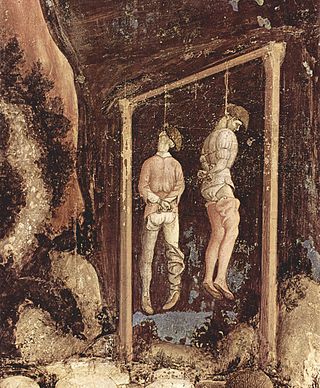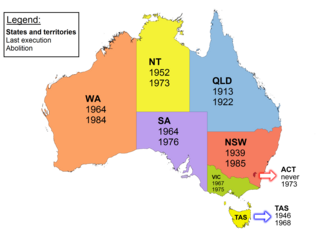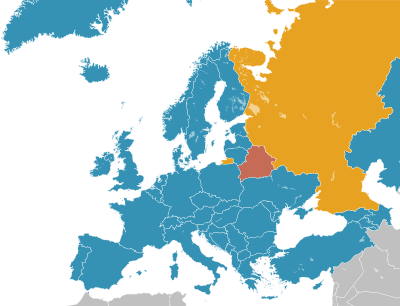Capital punishment, also known as the death penalty and formerly called judicial homicide, is the state-sanctioned killing of a person as punishment for actual or supposed misconduct. The sentence ordering that an offender be punished in such a manner is known as a death sentence, and the act of carrying out the sentence is known as an execution. A prisoner who has been sentenced to death and awaits execution is condemned and is commonly referred to as being "on death row". Etymologically, the term capital refers to execution by beheading, but executions are carried out by many methods, including hanging, shooting, lethal injection, stoning, electrocution, and gassing.

A gas chamber is an apparatus for killing humans or other animals with gas, consisting of a sealed chamber into which a poisonous or asphyxiant gas is introduced. Poisonous agents used include hydrogen cyanide and carbon monoxide.

Hanging is killing a person by suspending them from the neck with a noose or ligature. Hanging has been a standard method of capital punishment since the Middle Ages, and has been the primary execution method in numerous countries and regions. The first known account of execution by hanging is in Homer's Odyssey. Hanging is also a method of suicide.

Capital punishment is not allowed to be carried out in the U.S. state of California, due to both a standing 2006 federal court order against the practice and a 2019 moratorium on executions ordered by Governor Gavin Newsom. The litigation resulting in the court order has been on hold since the promulgation of the moratorium. Should the moratorium end and the freeze conclude, executions could resume under the current state law.
Capital punishment in Canada dates to Canada's earliest history, including its period as first a French then a British colony. From 1867 to the elimination of the death penalty for murder on July 26, 1976, 1,481 people had been sentenced to death, and 710 had been executed. Of those executed, 697 were men and 13 women. The only method used in Canada for capital punishment of civilians after the end of the French regime was hanging. The last execution in Canada was the double hanging of Arthur Lucas and Ronald Turpin on December 11, 1962, at Toronto's Don Jail. The National Defence Act prescribed the death penalty for certain military offences until 1999, although no military executions had been carried out since 1946.

Capital punishment – the process of sentencing convicted offenders to death for the most serious crimes and carrying out that sentence, as ordered by a legal system – first appeared in New Zealand in a codified form when New Zealand became a British colony in 1840. It was first carried out with a public hanging in Victoria Street, Auckland in 1842, while the last execution occurred in 1957 at Mount Eden Prison, also in Auckland. In total, 85 people have been lawfully executed in New Zealand.

Capital punishment in Singapore is a legal penalty. Executions in Singapore are carried out by long drop hanging, and usually take place at dawn. Thirty-three offences—including murder, drug trafficking, terrorism, use of firearms and kidnapping—warrant the death penalty under Singaporean law.

Capital punishment is a legal penalty in Japan. The Penal Code of Japan and several laws list 14 capital crimes. In practice, though, it is applied only for aggravated murder. Executions are carried out by long drop hanging, and take place at one of the seven execution chambers located in major cities across the country. The only crime punishable by a mandatory death sentence is instigation of foreign aggression.

Capital punishment has been completely abolished in all European countries except for Belarus and Russia, the latter of which has a moratorium and has not carried out an execution since September 1996. The complete ban on capital punishment is enshrined in both the Charter of Fundamental Rights of the European Union (EU) and two widely adopted protocols of the European Convention on Human Rights of the Council of Europe, and is thus considered a central value. Of all modern European countries, San Marino, Portugal, and the Netherlands were the first to abolish capital punishment, whereas only Belarus still practises capital punishment in some form or another. In 2012, Latvia became the last EU member state to abolish capital punishment in wartime.

Capital punishment is forbidden by the Charter of Fundamental Rights and Freedoms of the Czech Republic and is simultaneously prohibited by international legal obligations arising from the Czech Republic's membership in both the Council of Europe and the European Union.

Capital punishment in Finland has been abolished de jure.

Capital punishment is a legal penalty in Russia but is not used due to a moratorium and no death sentences or executions have been carried out since 2 August 1996. Russia has had an implicit moratorium in place since one was established by President Boris Yeltsin in 1996, and explicitly established by the Constitutional Court of Russia in 1999 and reaffirmed in 2009.
Execution by shooting is a method of capital punishment in which a person is shot to death by one or more firearms. It is the most common method of execution worldwide, used in about 70 countries, with execution by firing squad being one particular form.

Capital punishment in Australia has been abolished in all jurisdictions since 1985. Queensland abolished the death penalty in 1922. Tasmania did the same in 1968. The Commonwealth abolished the death penalty in 1973, with application also in the Australian Capital Territory and the Northern Territory. Victoria did so in 1975, South Australia in 1976, and Western Australia in 1984. New South Wales abolished the death penalty for murder in 1955, and for all crimes in 1985. In 2010, the Commonwealth Parliament passed legislation prohibiting the re-establishment of capital punishment by any state or territory. Australian law prohibits the extradition or deportation of a prisoner to another jurisdiction if they could be sentenced to death for any crime.
Capital punishment is a legal penalty in Israel. Capital punishment has only been imposed twice in the history of the state and is only to be handed out for treason, genocide, crimes against humanity, and crimes against the Jewish people during wartime. Israel is one of seven countries to have abolished capital punishment for "ordinary crimes only."

Capital punishment remained in Polish law until September 1, 1998, but from 1989 executions were suspended, the last one taking place one year earlier. No death penalty is envisaged in the current Polish penal law.
Capital punishment is a legal penalty in South Korea. As of August 2023, there were 59 people on death row in South Korea. The method of execution is hanging.
Capital punishment refers to the execution of an offender sentenced to death after conviction of a criminal offense. Capital punishment is legal in Afghanistan and can be carried out secretly or publicly due to the current governmental system. The main methods of execution employed by the Afghan government on convicts are hangings and shootings. Stoning, amputation, and flogging are also sometimes used as a method for punishment, and were especially prominent during the late 1990s. Public executions have existed throughout Afghanistan's history. The former Afghan government took important steps away from the use of the death penalty, but they have continued with the Taliban returning to power in August 2021. Some executions have been recently condemned by the United Nations. UN experts have called on Afghan authorities "to halt immediately all forms of torturous, cruel, and degrading forms of punishments." The capital offenses in Afghanistan include a range of crimes from murder to adultery, and are governed by Sharia, along with civil laws.
Capital punishment in South Africa was abolished on 6 June 1995 by the ruling of the Constitutional Court in the case of S v Makwanyane, following a five-year and four-month moratorium that had been in effect since February 1990.
Capital punishment is a legal penalty in Nigeria.









